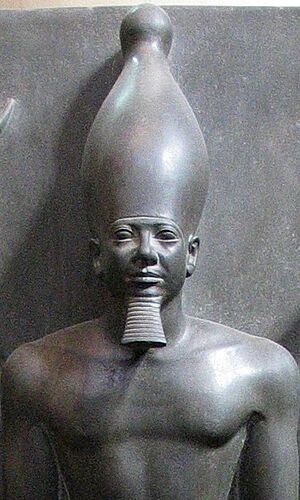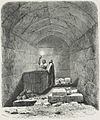Menkaure facts for kids
Quick facts for kids Menkaure |
|
|---|---|
| Menkaura, Mykerinos, Menkheres | |

|
|
| Pharaoh | |
| Reign | 18 to 22 years, starting c. 2530 BC (Fourth Dynasty) |
| Predecessor | Khafre (most likely) or Bikheris |
| Successor | Shepseskaf |
| Consort | Khamerernebty II, Rekhetre ? |
| Children | Khuenre, Shepseskaf, Khentkaus I ?, Sekhemre |
| Father | Khafre |
| Mother | Khamerernebty I |
| Born | 2532 BC |
| Died | c. 2500 BC |
| Burial | Pyramid of Menkaure |
Menkaure was an important pharaoh (king) of ancient Egypt. He ruled during the Fourth Dynasty, a time known as the Old Kingdom. You might also know him by his Greek names, Mykerinos or Menkheres.
Menkaure is famous for his amazing tomb, the Pyramid of Menkaure, located at Giza. He is also known for the beautiful statues found there. These statues often show him with the goddess Hathor and other local gods. Most historians believe he was the son and successor of Khafre, another famous pharaoh.
Contents
Menkaure's Family and Royal Connections
Menkaure was part of a very powerful royal family. He was the son of Khafre and the grandson of Khufu, who built the Great Pyramid of Giza.
Who were Menkaure's wives?
Menkaure likely had at least two wives. One was Khamerernebty II. She was the daughter of Khamerernebty I, who was Menkaure's mother. Another possible wife was Rekhetre, who was a daughter of Khafre.
Did Menkaure have children?
Yes, Menkaure had several children:
- Khuenre was the son of Queen Khamerernebty II. Sadly, he died before his father.
- Shepseskaf was Menkaure's successor and likely his son.
- Sekhemre is known from a statue and might have been another son.
- He also had a daughter who passed away when she was young.
- Khentkaus I is also thought to be one of his daughters.
Menkaure's royal court included his half-brothers. Many of them served as important officials called viziers. These brothers included Nebemakhet, Duaenre, Nikaure, and Iunmin. His brother Sekhemkare became a vizier after Menkaure's death.
How Long Did Menkaure Rule?
The exact length of Menkaure's reign is not fully known. Some ancient records suggest he ruled for a very long time, but this is probably not true. Most Egyptologists (people who study ancient Egypt) believe he ruled for about 18 to 22 years. This estimate comes from ancient records like the Turin King List and notes left by workers.
In 2013, a piece of a sphinx statue belonging to Menkaure was found in Tel Hazor. This shows how far his influence reached!
Menkaure's Pyramid Complex
Menkaure's pyramid at Giza was called Netjer-er-Menkaure, which means "Menkaure is Divine." It is the smallest of the three main pyramids at Giza. It stands about 65.5 meters (215 feet) tall and measures 103.4 meters (339 feet) at its base.
What are the smaller pyramids for?
Next to Menkaure's main pyramid, there are three smaller pyramids. These are sometimes called G-IIIa, G-IIIb, and G-IIIc. Historians think these smaller pyramids might have been built for Menkaure's queens. A statue of a queen was found in the chapel of G-IIIa, suggesting that Queen Khamerernebti II might have been buried in one of them.
The Valley Temple and Mortuary Temple
Near the pyramid, there were two important temples: the Valley Temple and the Mortuary Temple.
- The Valley Temple was mostly made of brick. Many famous statues of Menkaure were found here. These statues show him with his queen or with different gods and goddesses.
- The Mortuary Temple was also a place where statues and other important items were found. A piece of a wand belonging to Queen Khamerernebty I (Menkaure's mother) was discovered here.
The Mystery of Menkaure's Sarcophagus
In 1837, explorers found a large stone sarcophagus (a stone coffin) inside Menkaure's pyramid. It was made of basalt and was very large, but it had no hieroglyphs on it. Next to it, they found wooden pieces of a coffin with Menkaure's name and some human bones.
The sarcophagus was put on a ship to be sent to the British Museum in London. However, the ship, named Beatrice, was lost at sea after leaving Malta in 1838. The other items, like the wooden coffin pieces, were sent on a different ship and are now at the museum.
Historians now believe that the wooden coffin was a replacement made much later, during the Saite period, almost 2,000 years after Menkaure's death. The bones found were even more recent, from the Coptic period (the first centuries AD). This means the original sarcophagus and Menkaure's actual remains are still a mystery!
Stories from Later Times
The ancient Greek historian Herodotus, who lived around 430 BC, wrote about Menkaure. He said that Menkaure was the son of Khufu and that he was a much kinder ruler than his father. Herodotus also wrote that Menkaure faced many troubles. His only daughter died before him.
Herodotus tells a story that an oracle (a person who can see the future) predicted Menkaure would only rule for six more years. Menkaure was upset because he felt he was a good king, unlike his father and uncle. The oracle then told him that his good deeds were actually shortening his life because Egypt was meant to suffer for 150 years, and Menkaure was going against that fate.
To trick fate, Menkaure decided to turn night into day. He lit many lamps at night and spent his evenings celebrating and having fun. By doing this, he hoped to make his six years of rule feel like twelve years.
Fun Facts About Menkaure
- Menkaure was the subject of a poem called "Mycerinus" by the English poet Matthew Arnold in the 1800s.
- In the Night Huntress series of books by Jeaniene Frost, Menkaure (using his Greek name, Mencheres) is a major character. He is shown as a very old and powerful vampire living in modern times.
Images for kids



